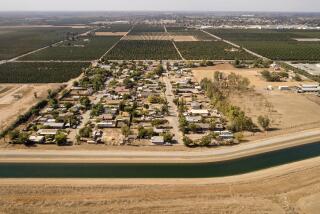Across the U.S., Y2K Problem Is in Various States of Repair
For the last five months, Robert Poe has been traversing the hinterlands of Alaska, pounding the cities and tundra in search of support for the state’s hobbled year 2000 repair effort.
Poe, who is in charge of the state’s computers, needs $18 million to tackle the 89 critical computer systems that are now vulnerable in some degree to the millennium bug. But in a state with a $1-billion deficit and a Legislature that has already turned down one year 2000 budget request, he is facing an uphill battle.
“The problem is just getting people to focus,” he said. “If you live in the bush, all you care about is your snow machine, your four-wheeler, your riverboat and your rifle. The rest is kind of unrelated to your daily life.”
With less than a year to go before Jan. 1, 2000, Alaska is one of several states that have fallen behind in the race against the millennium bug. Many of these lagging states are limping along in their repair efforts, often short of funds, direction and support.
These states form a weak spot in the technological web that radiates from the mammoth central systems of the federal government. While most of the attention has been focused on the repair of such heavyweight federal systems as defense and air traffic control, it is the states that deal with services that touch close to home, including unemployment insurance, food stamps, Medicaid, welfare and disability.
The problems of the states raise the unsettling prospect that even if the federal government completely repairs its critical systems, the delivery of important services could still be disrupted by the weak link of the states and the counties and cities below them.
According to a survey by the General Accounting Office conducted in November, only a third of the 421 computer systems used by the states to manage seven federal welfare programs were reported as repaired. The survey found state repair rates ranging from a low of just 16% for Medicaid systems to about half for the child-care and child-welfare computer systems.
The potential problems included overpayments to recipients, under-payments, delayed payments and denied benefits. In addition, a year 2000 failure could make the state unable to add new recipients and determine benefits for new applicants.
“Failure to complete year 2000 conversion could result in billions of dollars in benefit payments not being delivered,” the GAO report said.
The problem for many states has been a shortage of money and will to deal with a problem that seems to have grown in expense and complexity each year. Even in states where the problem is given priority, it still must compete against a host of other priorities for state funding.
Technological Glitch to Political Issue
In many ways, the troubles of the states mark the transformation of the year 2000 problem from a strictly technological glitch to a political issue that, to some legislators dealing with unemployment and budget deficits, sounds at times like babbling from the computer room.
The progress of the states covers a wide range that defies easy description. Some states, such as Nebraska, have leveraged the smaller size of their governments and manageable computer systems to finish ahead of schedule.
A narrow majority of states have done repairs on more than half their critical systems and expect to finish the rest in the next few months, according to an ongoing survey of states conducted by the National Assn. of State Information Resource Executives. The remaining work is expected to move quickly since the most time-consuming part of year 2000 repairs is the planning, assessing and testing that must take place before a system is repaired.
California is among the more advanced states, having finished about two-thirds of its critical systems, according to the state Department of Information Technology.
“At 50% finished, you’ve done maybe 80% of the work,” said Steve E. Kolodney, director of Information Services for Washington state and the chairman of NASIRE’s year 2000 committee. “They’re on the glide path that they set out for themselves. They’re pretty much on track.”
But progress in the remaining half of states is erratic at best. Alaska is at one end of the extreme, with only 15% of its computer systems repaired. Poe is still not certain the state will make its deadline.
“We don’t have any money and we are doing this all with our arms tied behind our backs,” he said. “We’re pressing the deadline, absolutely.”
Dropping lower through the hierarchy to counties and cities yields an even more erratic portrait of preparedness. According to a random survey of 500 U.S. counties in November by the National Assn. of Counties, nearly half have no countywide plans for repairing the computer glitch, allowing each of their agencies to deal with the problem on their own. Out of the 500 counties, 23 have not even taken the most basic step of assessing whether their systems are vulnerable to a year 2000 problem.
Washington, D.C., didn’t start work until June and now has completed repairs on only 2% of its critical systems, the worst completion level in the country.
Kolodney said that in some cases, small local governments may be able to get away with letting their computer systems fail and then fixing them afterward.
But the states exist in a middle zone where even the smallest still need a complex computer system to deal with the range of services they provide. “For a state, if you’re not ready, you’re out of the game,” Kolodney said.
The year 2000 problem, also known as Y2K, is caused by the long programming tradition of using two digits to represent years. In the 1960s, the abbreviation was used to save memory and disk space, both of which were precious commodities at the time.
The use of two digits has posed few problems so far. But in 2000, the abbreviation will create an ambiguous situation for computers. The year “00” could be interpreted as either “1900” or “2000.”
Programmers were aware of the problem for decades, but most assumed their computer systems would be replaced long before 2000 arrived. Instead, many systems were patched and expanded over the years to the point where replacing them became almost too complex to consider.
Fixing the problem at this point has become such a large undertaking not because it is a particularly difficult programming task, but because it involves three decades of code that has been strewn like dust through computers--from the tiny chips that control traffic lights to the programs that hold your Social Security information.
Difficulty in Justifying Costs
While the effects of the glitch are uncertain, just repairing the problem has already become a calamity of sorts by itself. The states by themselves will spend close to $3.5 billion on the Y2K problem, the federal government an estimated $6.5 billion. The federal government’s costs alone top the $6 billion in damage done by Hurricane Hugo in 1989.
The problem that every government agency and business has faced in dealing with the Y2K problem has been justifying the cost of repairs to simply make the systems work as they did before. It took years for the people in charge of computer systems to convince the people in charge of the money that it is a significant issue that must be dealt with.
Even at this late date, many states have put up no extra money for the repair effort, requiring agencies to deal with the problem as they do their regular work. “Y2K may be a priority, but it’s not a funding priority,” said Evonne Rogers, year 2000 project manager for the state of Wyoming.
In Rogers’ state, the total repair bill will eventually climb to about $27 million, but so far all the project has gotten is a $2.4-million loan from a state agency and about $550,000 from the governor’s contingency fund. So far, about a third of the state’s critical computer systems have been repaired.
The first efforts to get funding for Y2K were stymied two years ago because of a court mandate that forced the state to come up with $100 million to deal with school funding. Last year, Gov. Jim Geringer asked for $6 million for Y2K repairs, but his request was turned down by the Legislature for a variety of reasons, including the school funding issue and the Legislature’s skepticism that it would really take that much money and time to fix such a simple problem.
“It wasn’t taken as a problem of dire severity,” said Micheal Baker, House Republican co-chairman of the state’s joint appropriations committee. “Maybe it was naive of us, but here we are.”
In Alaska’s case, a budget request for $16 million was sent to the Legislature early last year. But because of concern about the state’s $1-billion deficit and confusion in the last hour of the last day of the session, the bill failed to get the 75% majority needed to dip into the state’s reserve funds.
The Republicans blamed the Democrats, who blamed the Republicans. Alaska state Sen. Johnny Ellis (D-Anchorage), the minority leader, said that many Democrats simply voted nay as a protest against the Republicans’ maneuvering on other issues.
“We had no problem with Y2K,” Ellis said. “We just thought it was a bad budget overall. There wasn’t a word of criticism for Y2K.”
The governor is asking the Legislature for close to $20 million this month, but time is quickly running out. “If we don’t get the money, well, certain systems just won’t get done in time,” Poe said.
The states that have been successful generally have had strong political support during the several years spent repairing the systems.
Nebraska, for example, is almost finished with its Y2K repairs, in part because of a decision by the Legislature--either by coincidence or prescience--to fund the project by using 2 cents of the cigarette tax. The funding extended for four years, giving the state a steady and stable supply of money to tackle the problem.
Money Alone Won’t Solve the Problem
But money is not the total solution to the problem. The repairs take time, stretching over several years. The complexity of the systems mean that unexpected problems are to be expected and delays are the norm.
Georgia has put more money into solving its problem than California, yet the state is struggling as only about 15% of its critical systems have been repaired. Close to half its critical systems are well into the testing phase.
Mike Hale, the state’s chief information officer and head of its Y2K project, said Georgia had been using a decades-old computer system, and the cost of repairing their Y2K defects, in some cases, was close to the cost of replacing them.
Most states have replaced parts of their computer networks, but Georgia has launched into what is probably the largest replacement project of all the states. Its total Y2K repair bill is expected to reach nearly $370 million.
The state will eventually reap the benefits of having a modern computer system, but for now, it is facing a hard deadline of July 1--the beginning of the state’s fiscal year.
Making the Deadline Meets With Skepticism
Kazim Isfahani, a Y2K analyst for Giga Information Group, is skeptical about whether all the states will make their deadlines.
“You’ll never get a state to admit that they won’t be done in time,” he said. “I would suspect some of them are overly optimistic.”
Isfahani was optimistic that most critical systems bearing on daily lives, such as welfare and unemployment, will be repaired in time. The states have no option on slipping the deadline and as the time draws nearer, they will begin to shift resources to ensure their systems are relatively clean, he said.
But he is concerned that few states have begun planning for the web of small failures that are inevitable with complex systems. So much effort has been focused on repairing critical systems that in most states, little attention or money has been dedicated to handling the weeks or even months after Jan. 1, 2000.
Charles Gerhards, Y2K project manager for the state of Pennsylvania, which is one of the few to have essentially finished its repair work, said the final phase of contingency planning is crucial even if all repairs are done.
“It’s the last major piece of the puzzle to be done,” he said.
Isfahani said that just six states have budgeted any money for contingency planning in case of failures. “Given when most states started work, it’s mostly been a triage effort,” he said. “Now it’s time they begin thinking about what they are going to do if there are failures.”
And he added: “There will be some failures.”
*
Ashley Dunn can be reached via e-mail at [email protected].
(BEGIN TEXT OF INFOBOX / INFOGRAPHIC)
Ready or Not
Most states have repaired the year 2000 problems in at least half their critical systems, an encouraging sign according to some experts. The completion rate of he remaining states covers a wide range. The District of Columbia, for instance, has repaired only about 2% of its critical systems. How states rank in their Y2K preparations.
* Sources: National Assn. of State Information Resource Executives, individual states.
(BEGIN TEXT OF INFOBOX / INFOGRAPHIC)
Slow Progress
A November survey found that only about a third of state computer systems dealing with seven major federal welfare programs were year-2000-compliant.
Medicaid
Compliant: 16%
Not compliant: 84%
Temporary Assistance for Needy Families
Compliant: 25%
Not compliant: 75%
Food stamps
Compliant: 24%
Not compliant: 76%
Child suppport enforcement
Compliant: 38%
Not compliant: 62%
Women, Infants and Children
Compliant: 38%
Not compliant: 62%
Child care
Compliant: 56%
Not compliant: 44%
Child welfare programs
Compliant: 51%
Not compliant: 49%
Source: “Year 2000 Computing Crisis,” U.S. General Accounting Office
More to Read
Sign up for Essential California
The most important California stories and recommendations in your inbox every morning.
You may occasionally receive promotional content from the Los Angeles Times.











